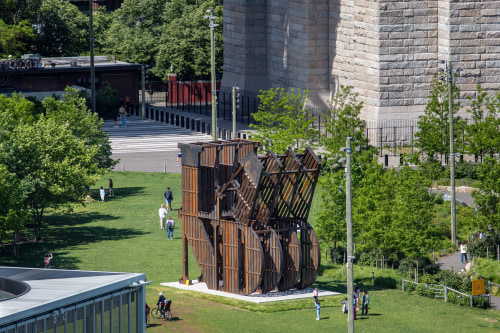
Nicholas Galanin’s Pointed Public Sculpture Inspires Glorious Noise in New York
By Andy Battaglia
November 10, 2023
Editor’s Note: This essay originally appeared in Reframed, the Art in America newsletter about about art that surprises us, about the works that get us worked up. Sign up here to receive it every Thursday.
The children playing by the 1920s-era carousel in Brooklyn Bridge Park had no idea what was about to fill their ears when guitar tones and drones from a violin started surrounding Nicholas Galanin’s imposing public sculpture nearby. Raven Chacon and Laura Ortman—two friends of Galanin who had been commissioned by the Public Art Fund to perform this past Sunday afternoon—were positioned with the iconic bridge as a backdrop, but the structure most integral to the proceedings was In every language there is Land / En cada lengua hay una Tierra, a 30-foot-tall sculpture made with the same kind of steel used for border walls between the US and Mexico. The work, with the word “LAND” rendered in the style of Robert Indiana’s LOVE sculpture, has a commanding sort of beauty about it. But there is a darkness—a disquieting acknowledgement of the violence and forced separation perpetrated in conflicts related to land—in it too.
Chacon and Ortman improvised a set of music that came just two days after Galanin and fellow artist Merritt Johnson asked the National Gallery of Art in Washington, D.C., to remove their work from “The Land Carries Our Ancestors: Contemporary Art by Native Americans,” a survey that counts as the first show of contemporary Native art at the institution in 70 years. Offered as a protest against America’s plans to provide funding to Israel for its military actions in Gaza, the move was a way to show how, as Galanin (Lingít/Unangax) and Johnson wrote, “the work we do as artists does not end in the studio or with our artist statements, it extends into the world.”
Chacon (Diné) and Ortman (White Mountain Apache), for their part, played noisy, spikey, discordant music that was impressively uninterested in the kind of uplifting style you might imagine at a daytime performance in a public park. They had just a few speakers at their disposal, but their sound was loud—and very much in line with the mood of a day that was both triumphant (it was the same day as the New York City Marathon, always an incontrovertible celebration of humanity) and distressing (it was yet another day when what seemed to be protest-provoked shouts in the distance signaled increasing unrest).
At one point, between spells of distorted static and shrieking lead lines that wouldn’t have been out of place at a heavy-metal concert, Chacon was hunched over his bank of guitar pedals when he looked up and spied a helicopter in the sky. He kept on looking, craning his head and twiddling the knobs at his feet while waiting for the chopper to follow its flight pattern and circle back. When it rounded a bend and crept closer, he locked his sound into a digital delay—whoomp, whoomp, whoomp, whoomp—that he timed almost perfectly with the slashing of the blades. Through these sounds, it was as if the earth and the sky had become one, with machinery brokering an accord that it also managed to mangle beyond recognition.
“Indigenous care for Land and community is rooted in connection based on mutual sustainability,” Galanin said in a statement around the unveiling of his sculpture, which went up in May and will remain in place into March of next year. “Rather than nationalism or capital, this perspective always embodies a deep respect for life beyond any single generation.”
The notion of a collective “deep respect for life” has felt cruelly elusive of late, as has the idea of any kind of collectivity that could continue for generations. But there both were, in a sculpture that seemed to suggest that the land on which we live is land we should share.